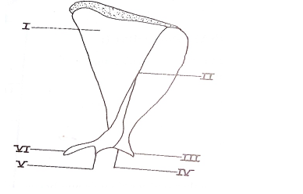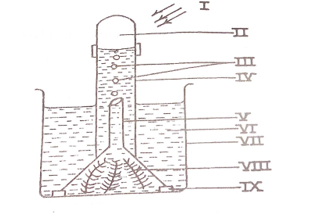Question 1
- (a) The diagram below is an illustration of a mammalian bone. .Study it carefully and answer questions 1(a) to (c).

(i)Identify the bone illustrated. [1 mark]
(ii) Name the parts labelled I to VI. [3 marks]
-
(i) Which bone fits into the part labelled IV. [1 mark]
(ii) Name the movable joint formed at IV. [1 mark]
- State two functions of the bone illustrated in the diagram in mammals. [2 marks] The diagram below illustrates an experimental set-up demonstrating a biological process in plants. Study it carefully and answer questions 1(d) to (g).
- Identify the parts labelled I to VIII. [4 marks]
- (i) What is the aim of the experiment? [1 mark]
(ii) Name two factors that can affect the result of the experiment. [2 marks] - (i) What type of liquid is used in the part labelled VI? [1 mark]
(ii) Name one organism that can be used in the part labelled VIII. [1 mark]
(iii) What process produced the substance labelled III? [1 mark]
(iv) Explain the test that confirms the nature of the substance labelled II. [2 marks]
(v) Suggest a suitable control for the experiment [1 mark] - Write a balanced chemical equation of the biological process involved in the experiment. [4 marks]

Observation
A few candidates could name the illustrated bone and label its parts fully, although some candidates lost marks to spelling errors. In questions 1(d) to (g), candidates were required to identify the parts of an experimental set-up to show that oxygen is released during photosynthesis. Candidates who performed well in this question were able to state the factors that affect the result of the experiment, while candidates that performed poorly could not write the balanced equation of photosynthesis and also how to set up the control experiment
The expected answers are:
1.(a) (i) Name of bone
Scapula/shoulder blade (of a mammal)
(ii) Names of labelled parts
I- Scapula blade;
II- Spine;
III- Coracoid process;
IV- Glenoid cavity;
V- Acromion;
VI- Metacromion.
(b)(i) Bone that fits into IV
Humerus
(ii) Joint formed at IV
Ball and socket joint
(c) Function of scapula in mammals
- Gives support;
- Gives shape;
- Attachment of muscles;
- Movement;
- Source of calcium.
(d)Identification of parts
I- Light rays/sunlight;
II- Gas/air/oxygen;
III- Bubbles/air bubbles/gas bubbles;
IV- Test tube/boiling tube;
V – Funnel/stem of funnel/filter funnel;
VI – Water/water containing carbon dioxide/dilute sodium hydrogen carbonate solution;
VII – Water trough/beaker;
VIII - Water plant/aquatic plant/any correctly named aquatic plant.
(f)(i) Type of fluid in the part labelled VI
Pond water/water/water containing carbon dioxide/dilute sodium hydrogen carbonate solution.
(ii) Name of organism in the part labelled VIII
Elodea/Ceratophyllum/Hornwort/Spirogyra/Hydrilla/any other correctly named water plant.
(iii) Process that produced the part labelled III
Photosynthesis
(iv) Test for confirmation of the substance labelled II
- Apply a glowing splint; it rekindles/glows brighter.
- Absorption of oxygen; by (alkaline) pyrogallol.
(v) Control of the experiment
Same apparatuses; put in a dark cupboard/in the dark; for two days.
(g)Balanced Chemical equation of photosynthesis
